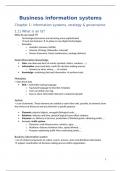Resume
Samenvatting Business Information systems
- Établissement
- Katholieke Universiteit Leuven (KU Leuven)
Volledige samenvatting van Business Information Systems, exclusief hoofdstuk 4, aangezien dit bijna allemaal praktische toepassingen zijn (UML, SQL, Excel). Complete summary of Business Information Systems, excluding chapter 4, as these are almost only practical applications (UML, SQL, Excel).
[Montrer plus]



